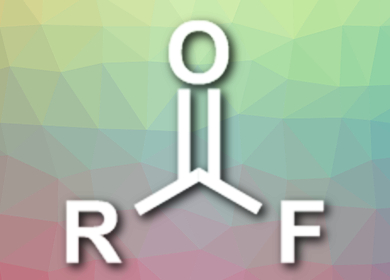Acyl fluorides (pictured) are useful reactive derivatives of carboxylic acids. They allow the easy synthesis of esters, amides, and other compounds. Acyl fluorides are easier to handle than the commonly used acyl chlorides. However, there is a lack of methods for their safe and selective synthesis, which hampers their application in synthesis.
Franziska Schoenebeck, RWTH Aachen University, Germany, and colleagues have developed a convenient and safe method for the transformation of carboxylic acids to acyl fluorides. The team used the bench-stable solid reagent (Me4N)SCF3 to convert a range of aliphatic and aromatic carboxylic acids to the corresponding acyl fluorides at room temperature in dichloromethane (DCM) or acetonitrile (MeCN).
The researchers investigated the reaction mechanisms and found that the (Me4N)SCF3 is first activated by the carboxylic acid, then reacts with a second molecule of acid, and is finally transformed to the acyl fluoride under release of carbonyl sulfide (COS) gas. The reaction can be performed at the gram scale and shows a good functional group tolerance.
- Direct Synthesis of Acyl Fluorides from Carboxylic Acids with the Bench-Stable Solid Reagent (Me4N)SCF3,
Thomas Scattolin, Kristina Deckers, Franziska Schoenebeck,
Org. Lett. 2017.
DOI: 10.1021/acs.orglett.7b02516



![A Path to Substituted Bicyclo[2.1.1]hexanones](https://www.chemistryviews.org/wp-content/uploads/2024/10/1substitutedbicyclo211hexan2ones_2024-125x94.png)
